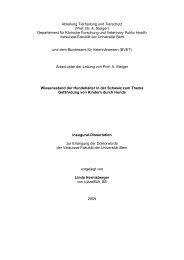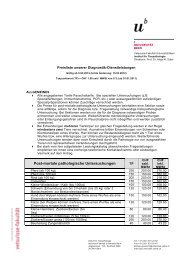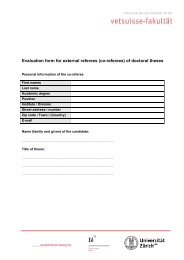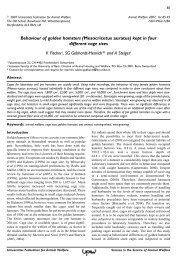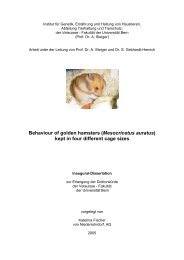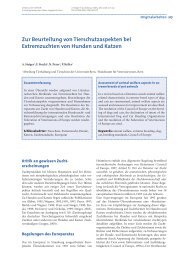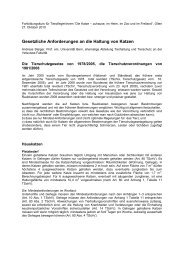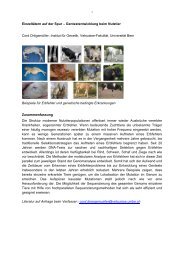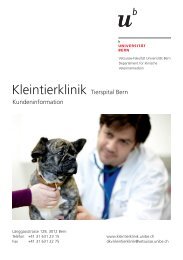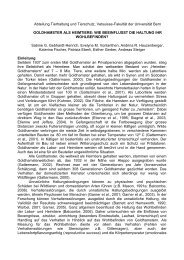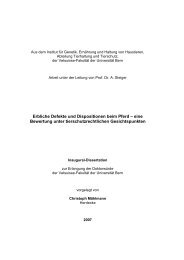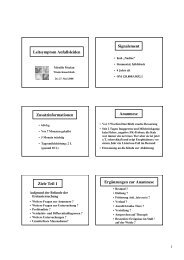Lifespan and Causes of Death in the Irish Wolfhound - Vetsuisse ...
Lifespan and Causes of Death in the Irish Wolfhound - Vetsuisse ...
Lifespan and Causes of Death in the Irish Wolfhound - Vetsuisse ...
Create successful ePaper yourself
Turn your PDF publications into a flip-book with our unique Google optimized e-Paper software.
1.3 Discussion <strong>and</strong> Conclusions (chapter 7)<br />
The third part discusses <strong>the</strong> f<strong>in</strong>d<strong>in</strong>gs <strong>of</strong> <strong>the</strong> previous chapters, <strong>the</strong>ir implications for<br />
future breed<strong>in</strong>g strategies, suggestions for fur<strong>the</strong>r research <strong>and</strong> also conta<strong>in</strong>s a<br />
general discussion <strong>of</strong> <strong>the</strong> ethics <strong>of</strong> breed<strong>in</strong>g <strong>Irish</strong> <strong>Wolfhound</strong>s.<br />
1.3.1 <strong>Lifespan</strong><br />
Accord<strong>in</strong>g to <strong>the</strong> literature, <strong>the</strong> early accumulation <strong>of</strong> oxidative damage dur<strong>in</strong>g growth<br />
plays an important role <strong>in</strong> <strong>the</strong> reduced lifespan observed <strong>in</strong> large <strong>and</strong> giant dog<br />
breeds. Even though <strong>the</strong>re is some disagreement between <strong>the</strong> different lifespan<br />
estimates for <strong>Irish</strong> <strong>Wolfhound</strong>s, <strong>and</strong> despite <strong>the</strong> right censored data <strong>in</strong>fluence this<br />
study found, it is abundantly clear that <strong>the</strong> breed has a generally poor life<br />
expectancy, <strong>and</strong> that steps should be taken to improve <strong>the</strong> situation. It is possible<br />
that <strong>Irish</strong> <strong>Wolfhound</strong> life expectancy varies between different countries, although<br />
o<strong>the</strong>r mechanisms could also have <strong>in</strong>fluenced this result.<br />
It is hypo<strong>the</strong>sised that <strong>the</strong> observed decrease <strong>in</strong> average lifespan s<strong>in</strong>ce <strong>the</strong> 1960s<br />
could be caused by a lack <strong>of</strong> health-related selection pressure due to <strong>the</strong> <strong>in</strong>creased<br />
availability <strong>of</strong> veter<strong>in</strong>ary care (antibiotics <strong>and</strong> vacc<strong>in</strong>es) s<strong>in</strong>ce <strong>the</strong>se times. The<br />
exponential <strong>in</strong>crease <strong>in</strong> numbers s<strong>in</strong>ce <strong>the</strong>se times may also have contributed to<br />
such a decrease <strong>in</strong> selection pressure, as may <strong>the</strong> <strong>in</strong>creas<strong>in</strong>g tendency to have many<br />
small kennels as opposed to a few large ones.<br />
Based on <strong>the</strong> f<strong>in</strong>d<strong>in</strong>gs on castration, it is recommended not to rout<strong>in</strong>ely castrate male<br />
<strong>Irish</strong> <strong>Wolfhound</strong>s due to both its lack <strong>of</strong> benefit regard<strong>in</strong>g lifespan <strong>and</strong> its <strong>in</strong>crease <strong>of</strong><br />
osteosarcoma risk. However, it is likely that castration significantly <strong>in</strong>creases life<br />
expectancy <strong>in</strong> female <strong>Irish</strong> <strong>Wolfhound</strong>s.<br />
1.3.2 Population Genetics<br />
<strong>Irish</strong> <strong>Wolfhound</strong>s have been subject to at least four important genetic bottlenecks<br />
dur<strong>in</strong>g <strong>the</strong>ir modern history, with <strong>the</strong> most recent occurr<strong>in</strong>g <strong>in</strong> <strong>the</strong> 1950s. This makes<br />
<strong>the</strong> breed highly <strong>in</strong>bred, which may expla<strong>in</strong> <strong>the</strong> lack <strong>of</strong> <strong>in</strong>fluence <strong>of</strong> <strong>in</strong>breed<strong>in</strong>g on<br />
lifespan found <strong>in</strong> this study: Inbreed<strong>in</strong>g <strong>and</strong> bottlenecks can lead to "purg<strong>in</strong>g"<br />
phenomena, through which deleterious alleles can be elim<strong>in</strong>ated from an <strong>in</strong>bred<br />
population.<br />
The high <strong>in</strong>breed<strong>in</strong>g level <strong>in</strong> <strong>Irish</strong> <strong>Wolfhound</strong>s today tends to be masked due to <strong>the</strong><br />
exponential population growth <strong>in</strong> recent times; <strong>in</strong> fact, <strong>the</strong>re is an artificial decrease <strong>in</strong><br />
10-generation Wright's <strong>in</strong>breed<strong>in</strong>g coefficients <strong>in</strong> more recent times due to this<br />
phenomenon.<br />
The observed ancestor differences for <strong>the</strong> diseases considered were difficult to<br />
<strong>in</strong>terpret <strong>in</strong> <strong>the</strong> case <strong>of</strong> DCM, OS <strong>and</strong> GDV, s<strong>in</strong>ce <strong>the</strong>y seemed to be similar <strong>in</strong> all<br />
three diseases. In <strong>the</strong> case <strong>of</strong> PSS, however, differences were more clear <strong>and</strong> lead to<br />
<strong>the</strong> construction <strong>of</strong> a few pedigree diagrams, through which probable orig<strong>in</strong>ators <strong>of</strong><br />
<strong>the</strong> disease could be identified.<br />
4



